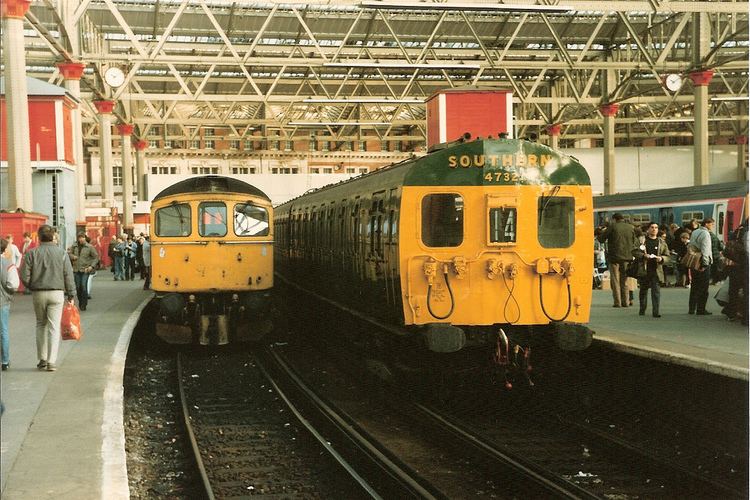In service 1941–1983 Number built 185 new built sets | Manufacturer SR Eastleigh Maximum speed 75 mph 121 km/h | |
 | ||
Formation power car + 2 trailer cars + power car Operator(s) Southern Railway and British Railways (Southern Region). | ||
The Southern Railway (SR) and the British Railways (Southern Region) (BR(S)) used the designation Sub to cover a wide variety of electric multiple units that were used on inner-suburban workings in the South London area. The designation ‘Sub’ was first officially used in 1941 to refer to newly built 4-car units. However, during the 1940s large numbers of earlier ‘3-Car Suburban Sets’ were increased to four cars by the addition of an 'Augmentation' trailer, and became part of the 4-Sub category. The SR and BR (S) continued to build or else rebuild 4-car units to slightly different designs which became part of the 4-Sub Class. Many of these later examples survived in passenger use until late 1983, by which time British Rail had allocated to them TOPS Class 405.
Contents
3-Car Suburban Sets
In 1923 the Southern Railway inherited 84 3-car suburban electric multiple units from the London and South Western Railway (LSWR), dating from 1914. These could be enhanced by 24 2-car trailer sets coupled between two units, creating 8-car formations. Over the next 18 years the SR acquired a further 516 3-car sets. These were either new; rebuilt from steam stock inherited from the LSWR, the London Brighton and South Coast Railway (LBSCR) and the South Eastern and Chatham Railway; or rebuilt from LBSCR AC multiple units. Some rebuilt units has ‘torpedo style’ front ends, others had the newer, flatter, front ends used on the main-line stock introduced during the early 1930s. They were designated ‘3-Car Suburban Sets’ to differentiate them from main-line units, and were numbered between 1201 and 1800. They are sometimes referred to as ‘3-Sub units’, but this designation does not appear to have been used whilst they were in use.
The 3-car units ultimately proved to be inadequate for most trains and inconvenient as the trailer sets had no driving cabs and so had to be marshaled between two 3-car units. Therefore, many were augmented by the addition of a new trailer car and rebuilt as 4-Sub units between 1942 and 1948. The remainder of the 3-car units were withdrawn. The last 2-car trailer set was withdrawn in September 1948, and the last 3-car formation ran in 1949.
4-Sub Units
In 1939, following the appointment of Oliver Bulleid as Chief Mechanical Engineer, the SR announced a new welded steel 4-car suburban unit with curved sides, seating six passengers across rather than the normal five. The prototype unit, 4101, was not completed until 1941 due to the advent of the Second World War. This had composite (both First Class and Third Class) seating accommodation in one trailer car and domed cab roofs. A further nine units were built in 1944-5 with Third Class accommodation only. Twenty units were introduced from 1946 with a vertical, ‘slab’ front end, and Third Class accommodation only. The underframes were built at Lancing Carriage Works and the bodies at Eastleigh Works.
As mentioned above, between 1942 and 1948 many 3-Car Suburban Sets were rebuilt and enhanced by the addition of a new 'Augmentation' trailer car to create 4-Sub units. This was done by inserting new steel trailers rather than one of the existing trailer cars. The rebuilt units were renumbered between 4131 and 4249.
BR(S) continued to introduce 4-Sub units, both new and converted from existing units, until 1951.
Formations
The usual formation for the newly built units was to have a Driving Motor Brake Third (DMBT) car at each ends, with accommodation for 108 passengers in nine compartments, together with two Trailer Third (TT) cars between with ten or eleven compartments giving a total passenger accommodation for 456 in all four coaches. (After the renaming of 'Third Class' to 'Second Class' in 1956 these became DMBS and TS respectively.) However some of the rebuilds had Trailer Composite (TC) cars. The earlier coaches provided compartments, whereas the post war newly built carriages tended to provide saloon or semi-saloon style accommodation to allow for more standing room. These new 'open' carriages were designated DMBTO or TTO.
Usage
Throughout their careers the 4-Sub units were used on the London suburban services of all three divisions of BR (S).
Withdrawal
The rebuilt units began to be withdrawn in the late 1950s and all had been withdrawn by the end of the 1960s. Apart from a few accident damaged units, the newly built units began to be withdrawn in 1972, and had all been withdrawn by 1983. Those units surviving in the early 1970s were designated as British Rail Class 405 under the TOPS computer system.
Preservation
A handful of Sub stock carriages have survived in preservation, thus:
